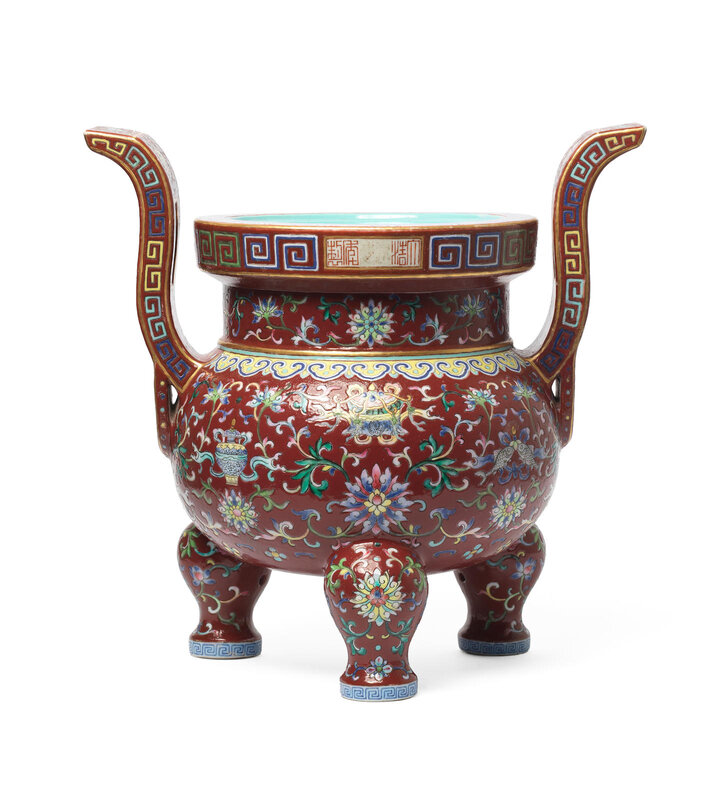The globular body enamelled with the Eight Buddhist Emblems surrounded by lotus blossoms issuing from foliate scrolls all reserved against a maroon-ground, beneath a band of ruyi heads below the neck with further lotus scrolls, the pierced upright curved handles on each side with further lotus flanked by yellow bats, the three stoutly rounded cabriole legs each with a lotus bloom in foliate scrolls, fitted box.
Provenance: Christie's, 'The Cowdray Sale: Works of Art from Cowdray Park and Dunecht House, Cowdray Park, West Sussex', 13-15 September 2011, lot 237.
Note: This incense burner is likely to have been part of a five-piece altar garniture set, known as the 'Five Offerings' (wugong 五供), which were widely used in Buddhist rituals to seek protection from the deities. In shape and decoration, the vessels included in these sets, which also comprised a pair of candlesticks and wine containers, recall those employed to perform ancestral sacrifices during the Shang and Zhou periods. Restoring the ancient Chinese ways through the reinterpretation of archaic forms was viewed by the Qing rulers as one way to reinstate the importance of performing filial acts, the core value of Confucian thought that legitimised the emperors' right to rule.
Compare with a ruby-ground set in the National Palace Museum, Taipei, included in the Museum's exhibition A Special Exhibition of Incense Burners and Perfumers Throughout the Dynasties, Taipei, 1994, no.105. See also an incense burner illustrated by G.Avitabile, From The Dragon's Treasure: Chinese Porcelain from the 19th and 20th Centuries in the Weishaupt Collection, London, 1987, no.5, p.22. Compare with another similar incense burner in the Nanjing Museum, illustrated in The Official Kiln Porcelain of the Chinese Qing Dynasty, Shanghai, 2003, pp.374-375.
Bonhams. Fine Chinese Art, 08.11.2018

/https%3A%2F%2Fprofilepics.canalblog.com%2Fprofilepics%2F1%2F0%2F100183.jpg)
/https%3A%2F%2Fstorage.canalblog.com%2F03%2F02%2F119589%2F96711876_o.jpg)
/https%3A%2F%2Fstorage.canalblog.com%2F11%2F31%2F119589%2F94773502_o.jpg)
/https%3A%2F%2Fstorage.canalblog.com%2F20%2F83%2F119589%2F94772815_o.jpg)
/https%3A%2F%2Fstorage.canalblog.com%2F26%2F72%2F119589%2F75604929_o.jpg)
/https%3A%2F%2Fstorage.canalblog.com%2F59%2F60%2F119589%2F26458628_o.jpg)



/image%2F1371349%2F20240519%2Fob_0c1e8c_telechargement-4.jpg)
/image%2F1371349%2F20240519%2Fob_97a567_telechargement-2.jpg)
/image%2F1371349%2F20240519%2Fob_61b60d_telechargement.jpg)
/image%2F1371349%2F20240519%2Fob_f0dea1_3825304-563x367-width-100.jpg)